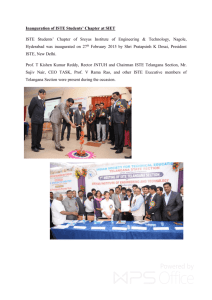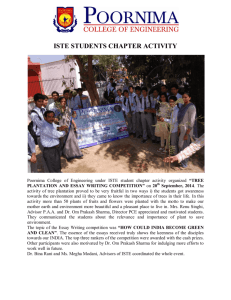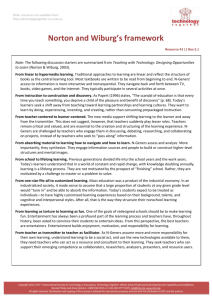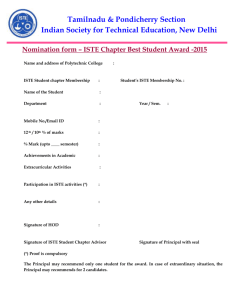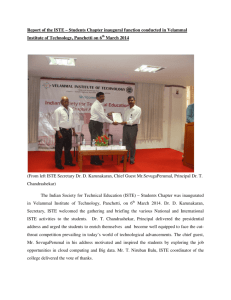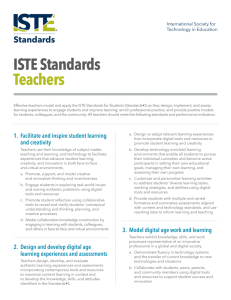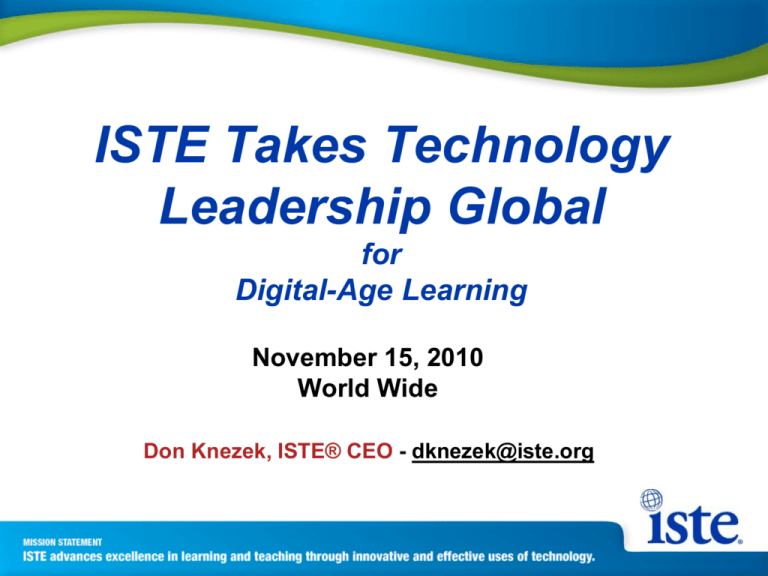
ISTE Takes Technology
Leadership Global
for
Digital-Age Learning
November 15, 2010
World Wide
Don Knezek, ISTE® CEO - dknezek@iste.org
The Challenge?
Preparing a Digital
Generation . . .
Building capacity for transformation
“It is not the
strongest of the
species that
survives, nor the
most intelligent; it
is the one that is
most adaptable to
change.”
Charles Darwin
What’s New?
What is different today in
schooling and learning
compared to a decade
ago?
What’s New?
Globalization, multiculturalism, competitiveness
Different expectations and learner styles
A learning landscape that is increasingly digital
New tools and new structures
Implications of the continuing digital divide
Accountability and competition
What do we know?
National Boundaries Don’t Matter:
• Expectations for Technology are Global
• A Shared Vision is Critical
• Knowledgeable Shared Leadership is Key
• Essential Conditions are Essential
• Skilled Teachers are Necessary
• Planning and Monitoring Must Inform and
Ensure Transformation
When organizations
collaborate in education,
children win!
Digital learning
environments enable more
effective strategies … each
of which engages more
students more deeply in
learning ...
Transforming Learning Environments
Traditional Environments
One-to-One Environments
Teacher directed, memoryfocused instruction
Student-centered, performancefocused learning
Isolated work on invented
exercises
Collaborative work on
authentic, real-work projects
Factual, literal thinking for
competence
Creative thinking for innovation
and original solutions
Primary focus on school and
local community
Expanded focus including
digital global citizenship
Isolated assessment of
learning
Integrated assessment for
learning
Knowledge from limited,
authoritative sources
Learner-constructed knowledge
from multiple information
sources and experiences
Opportunities Expand in
Digital Learning Environments
Information & Expertise – From wide array of online
sources
Learning Time – Expands to anytime students have
access and connectivity
Learning Teams – Less restricted, more accessible,
nurture global competence
Relevance – Authentic projects & problems that matter,
real data, in a digital-age context & in digital-age work &
learning environments
New-Century Literacies & New Skills – Learners
employ new knowledge and competencies
Equity
Many Faces of Innovation
Innovation around the edges …
• Length of the school year
• Class size
• Learning management/content management
systems
• Data systems and data usage
• Virtual schooling and online learning
• Assessment of learning
Essential Conditions
are Critical ...
www.iste.org/nets
Essential Conditions
Shared Vision
Technical Support
Implementation
Planning
Curriculum Framework
Student-Centered
Learning
Assessment and
Evaluation
Consistent and
Adequate Funding
Equitable Access
Skilled Personnel
Engaged Communities
Ongoing Professional
Support Policies
Learning
Supportive External
Context
Many Faces of Innovation
Innovation at the heart of student learning …
• Students use tools available to them outside of school
• Students with tools, resources and strategies used by
contemporary professionals in the discipline
• Students learn and work collaboratively in teams for authentic
project-based, problem-based, and challenge-based learning
• Students learn through simulations and serious games
• Teachers model 21st Century work and 21st Century learning
• There is a culture of co-learning and personal relevance
• Assessment is for learning; enriched accountability
• Learning, teaching, and assessment are no longer isolated,
individual endeavors
Changing the Student
Learning Experience...
Many Faces of Innovation
Innovation at the heart of student learning …
Using their tools for learning
Working like contemporary professionals
Learning in teams
Using games, simulations, competitions
Complex, authentic problems and projects
Teaches modeling as 21st Century professionals
Culture of co-learning; personal relevance
Rich assessment for learning
Learning, teaching and assessment as social
activities
Shame on us if we fail to
take advantage of
technology and
connectivity to change
the learning experience!
ISTE’s Work Globally
Consultancy for Defining ICT Expectations
Development of PD Leaders and ICT Mentors
Leadership Development for Technology
Strategic Planning for Digital-Age Education
Networking Events & Community Building
Membership Development
ISTE’s
Global Digital-Age
Learning, Teaching, and
Education Leadership
Skills ...
Adopted in the U.S. as ISTE’s
NETS
ISTE’s Global Digital-Age Learning Skills
“What students should know and be
able to do to learn effectively and live
productively in an increasingly digital
world …”
ISTE Global Digital-Age Learning Skills
•
Creativity and Innovation
•
Communication &
Collaboration
•
Research & Information
Fluency
•
Critical Thinking,
Problem-Solving, &
Decision-Making
•
Digital Citizenship
•
Technology Operations
and Concepts
NETS•S: Student Expectations 1998
Basic Operations and
Concepts
Social Ethical and Human
Issues
Technology Productivity
Tools
Technology
Communications Tools
Technology Research
Tools
Technology ProblemSolving and DecisionMaking Tools
•
Paradigm shift in focus
from “learning to use
the technology” to
“using the technology
to learn”
New focus - “What
students need to know
and be able to do to
learn effectively and
live productively in an
increasingly digital
world”
ISTE’s Global Digital-Age Learning Skills
The Next Generation
Creativity and Innovation
–
Students demonstrate creative thinking, construct
knowledge, and develop innovative products and
processes using technology.
Communication and Collaboration
–
Students use digital media and environments to
communicate and work collaboratively, including at a
distance, to support individual learning and contribute
to the learning of others.
Copyright © 2007 INTERNATIONAL SOCIETY FOR TECHNOLOGY IN EDUCATION All rights reserved. No part of this material
may be reproduced without written permission from copyright owner. Contact permissions@iste.org.
ISTE’s Global Digital-Age Learning Skills
The Next Generation
Research and Information Fluency
–
Students apply digital tools to gather,
evaluate, and use information.
Critical Thinking, Problem-Solving &
Decision-Making
–
Students use critical thinking skills to plan and
conduct research, manage projects, solve
problems and make informed decisions using
appropriate digital tools and resources.
Copyright © 2007 INTERNATIONAL SOCIETY FOR TECHNOLOGY IN EDUCATION All rights reserved. No part of this material
may be reproduced without written permission from copyright owner. Contact permissions@iste.org.
ISTE’s Global Digital-Age Learning Skills
The Next Generation
Digital Citizenship
–
Students understand human, cultural, and
societal issues related to technology and
practice legal and ethical behavior.
Technology Operations and Concepts
–
Students demonstrate a sound understanding
of technology concepts, systems and
operations.
Copyright © 2007 INTERNATIONAL SOCIETY FOR TECHNOLOGY IN EDUCATION All rights reserved. No part of this material
may be reproduced without written permission from copyright owner. Contact permissions@iste.org.
Adapting ISTE’s NETS Around
the World
ISTE Standards Work
Outside the US:
• Brazil
• Canada
• Costa Rica
• China
• India
• Malaysia
• Mexico
• The Philippines
• UAE & Gulf Region
• UNESCO Collaboration
NETS (U.S.) - SOL (Australia)
• Creativity and Innovation
• Creating with ICT
• Communication and
Collaboration
• Communicating with ICT
• Research and Information
Fluency
• Inquiring with ICT
• Critical Thinking, Problem- • (See National Goals for
Solving & Decision-Making
Schooling in 21st C)
• Digital Citizenship
• Ethics Issues and ICT
• Technology Operations
• Operating ICT
NETS
–
Critical Thinking, Problem-Solving &
Decision-Making
Students use critical thinking skills to plan
and conduct research, manage projects,
solve problems and make informed
decisions using appropriate digital tools
and resources. Students:
a. identify and define authentic
problems and significant questions for
investigation.
b. plan and manage activities to develop
a solution or complete a project.
c. collect and analyze data to identify
solutions and/or make informed
decisions.
d. use multiple processes and diverse
perspectives to explore alternative
solutions.
National Goals
National Goals for Schooling in 21C
When students leave schools they
should:
have the capacity for, and skills in,
analysis and problem solving and the
ability to communicate ideas and
information, to plan and organise
activities and to collaborate with others.
A Process of National Consensus in
Costa Rica
Costa Rica Student Performance Standards in
Digital Technology-Enhanced Learning
Properties
Creativity
Logical Reasoning
Collaboration
Ethics
Proactivity
Dimensions
Problem-Solving and Investigation
Productivity
Citizenship and Communication
A Broad-Based Development Team
in Malaysia
An Inclusive Process of
Consensus-Building
Seven Pillars of Student ICT Standard
DRAFT
Use ICT in an accountable and ethical manner
Select and apply appropriate ICT resources
Use ICT to seek, gather, process and utilize information
Use ICT to acquire and share knowledge
Use ICT for solving problems and making decisions
Use ICT to enhance productivity and learning
Use ICT to express ideas and information creatively and
innovatively
Teaching Digital-Age
Learners ...
Teaching in the Digital Age
Teaching is no longer an isolated endeavor
New teachers have to motivate and inspire
New teachers are digital learners and digital
workers
Teachers today must model behaviors of a 21st
Century professional
Successful teachers are co-learners (with students
and with colleagues)
Teachers in the digital age continue to grow
professionally, and they lead
ISTE NETS•T 2008
Facilitate and Inspire
Student Learning &
Creativity
Design and Develop DigitalAge Learning Experiences
and Assessments
Model Digital-Age Work and
Learning
Promote and Model Digital
Citizenship and
Responsibility
Engage in Professional
Growth and Leadership
ICT-CFT: the Matrix of Skill Sets
Tarek Shawki, UNESCO
ICT-CFT Phases and Outputs
Phase 1: Policy framework, modular structure, syllabus in 6 languages
http://www.unesco.org/en/competency-standards-teachers
Tarek Shawki, UNESCO
ISTE and Teaching in the 21st Century
in México
Agreement with the Subsecretary for Basic
Education, Spring 2010
Development of criteria for multi-level digital
teaching credential (ISTE and UNESCO standards)
Collaborate with CONOCER (Mexico’s liscensing
agency) for program implementation
Support the development and alignment of student
learning objects to the ISTE standards
Lead pilot projects in six states for credentialaligned teacher development
Toward Digital Age
Leadership ...
School Leaders Leading and
Modeling…
•
Shared Leadership
• A Digital- Age Learning
Culture
• Excellence in
Professional Practice
• Continuous Improvement
• Modeling Digital
Citizenship
Skills for Digital-Age Leaders
Visionary Leadership
- Inspire and lead the transformation of learning
Culture of Digital-Age Learning
- Create a culture, guarantee innovation
Excellence in Professional Practice
- Ensure professional learning and innovation
Systemic Improvement
- Improve continuously
Digital Citizenship
- Model
School Leaders Supporting and Participating
in Models of Professional Learning
Leaders Modeling
Professional
Learning
Culture of CoLearning
ICT Coaches or
Mentors
Virtual Communities
of Practice
http://istelearning.org
Relevant ISTE activities worldwide
•
Development of standards in Costa Rica, Malaysia, Mexico,
Canada, Gulf Region of the Middle East, Brazil and other
countries and states.
•
Hosting and organizing conferences in Singapore, China, Dubai,
the Neatherlands, the Czech Republic, Qatar and the United
States.
•
Supporting strategic planning in Mexico, Panama, Switzerland,
the Neatherlands, Germany, Canada, Jamaica, the Philippines and
U.S. States such as Arizona and Nevada.
•
Supporting the development of ICT mentors in Singapore, Puerto
Rico, and the U.S. State of Pennsylvania.
Relevant ISTE activities worldwide
•
Development for technology leadership among education leaders in
Germany, Canada, the Neatherlands, Bermuda and in very large
systems in the United States including Chicago, Miami and Los
Angeles.
•
Recently added affiliates in India, the UK, Australia, and we have
others is the process of applying from Latin America.
•
Doubled our non-US individual membership in three years;
significant non-US & multinational corporate representation
•
Collaborated with ISTE Corporate Members to explore and enter
other markets around the world with conference exhibit,
presentation, and sponsorship opportunities, with trade missions
abroad, and through hosting of education buyer delegations in the
U.S.
And, a bit about
ISTE and how we
can help …
Who is ISTE?
Premier International Organization for ICT in Primary and Secondary Schools
■
Worldwide Network of Leaders in Education and Technology
■
20,000+ Direct Individual Members
■
80+ Geographic Affiliates (ATLE, MassCUE, ACCE, CA CUE)
■
Reach of 150,000+ Individuals with Affiliates
■
Corporate Partners; ISTE Corporate Relations Program
■
Special Interest Groups (20)
■
Array of Strategic Allies (UNESCO, Ministries of Ed, Associations)
■
Advocate for Digital-Age Schooling Worldwide
www.iste.org
ISTE Members
Individuals
Affiliates
Institutions
Corporate Solution Providers
Member Academic Specialization
ISTE Members
ISTE Non - U.S. Online Memberships
Individual Membership
Institutional Membership – Starting at $ 599 USD
Special Interest Groups
SIGAdmin
Innovative learning
technologies
Technology coordinators
SIGOL
Special education technology
SIGTC
Media specialists
SETSIG
Games & simulations
SIGILT
Teacher educators
SIGMS
Independent Schools
SIGGS
International Schools
SIGIS
SIGTE
Mobile Computing
SIGints
Education Leaders
SIGMC
Online learning
SIG1to1
One-to-one computing
ISTE Corporate Members
Adaptive Curriculum
Apple
Cisco Systems
Discovery Education
HP
Intel
Promethean
SANAKO
Smart Technologies
Adobe
Atomic Learning
DELL
Epson
Microsoft
Oracle Education
Pearson
Reile
Scholastic
What does ISTE do?
Premier International Organization for ICT in Primary and Secondary Schools
ISTE Vision: ISTE advances
excellence in learning and
teaching through innovative
and effective uses of
technology.
The Resources Keep Coming
New Titles
E-Book versions
Amazon.com’s Kindle
Apple’s iPad
Barnes & Noble’s Nook
Books in Translation
Learning & Leading with Technology
•
ISTE’s Flagship
Magazine
•
Practical, usable
ideas for improving
educational
outcomes with
technology
Professional Research Journal Articles
The Journal of Research on Technology in Education (JRTE)
and the Journal of Computing in Teacher Education (JCTE)
each have a broad international audience.
Networking and Community
www.iste2010.org
ISTE’s Annual Conference and Exposition
Late June
Formerly NECC
Learn, exchange, and survey the field of ed tech
Largest educational technology program globally
Largest ed tech exhibition in the Americas (450 exhibits)
18,000 + attendees and exhibitor representatives
70 + countries represented this year
Your window on the world for ICT in learning
ISTE 2011 - Conf and Expo - Philadelphia - June 26-29
ISTE 2011 - Philadelphia
www.iste2011.org
MEET ISTE F2F in Your Region of the World
www.iste.org
iCTLT 2010
March 3 - 6
Singapore
www.ictlt.com
ACEC 2010
April 6 - 9
Melbourne
http://acec2010.info
ISTE Webinar Series
2008-2009 Schedule
Includes:
Technology for Nonreaders/K-2
Project-based Learning
Open Source
Collaborative
Applications
Introduction to Web 2.0
and much more!
ISTE Members are here
ISTE Island in Second Life
Virtual Networking Opportunities
“You have no idea what ISTE’s
Second Life has meant to me—here
in Macedonia, professionallyspeaking.”
-- Linda Fahlberg-Stojanovska,
Bitola, FYR Macedonia
aka “Janita Collins”
Advocacy
• ISTE Government Affairs
• Grassroots Efforts
• Policy-Bodies, Agencies
• Association & Coalition Ldrshp
• Media, Summits, Speaking
• Consultancy, Advisory
Advocate for resources and policies supporting the
effective use of technology to improve teaching,
learning, and leadership.
www.iste.org/about-iste/advocacy.aspx
Challenges for Education Leaders
•
Study digital-age learners and what
engages them …
Foster creative and inventive thinking for
innovation …
Understand what tools and strategies are
available and why they are important…
Sustain our own learning and R&D …
Prepare to support an increasingly digital,
connected, and multicultural setting …
Nurture innovation at the heart of
learning – in the student experience …
What’s Better? For Whom?
Thank You!
Contact us at
dknezek@iste.org
Visit us at www.iste.org

